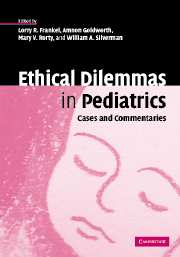Book contents
- Frontmatter
- Contents
- List of contributors
- Preface
- Introduction
- Part I Therapeutic misalliances
- Part II Medical futility
- Part III Life by any means
- 7.1 Where should a child die?
- 7.2 Where should a child (in the USA) die?
- 7.3 Topical discussion
- 8.1 Infant heart transplantation and hypoplastic left heart syndrome: what are the ethical issues?
- 8.2 Infant heart transplantation and hypoplastic left heart syndrome: a response
- 8.3 Topical discussion
- 9.1 Liver and intestinal transplantation
- 9.2 Transplantation and adolescents
- 9.3 Topical discussion
- Part IV Institutional impediments to ethical action
- References
- Index
8.2 - Infant heart transplantation and hypoplastic left heart syndrome: a response
Published online by Cambridge University Press: 18 August 2009
- Frontmatter
- Contents
- List of contributors
- Preface
- Introduction
- Part I Therapeutic misalliances
- Part II Medical futility
- Part III Life by any means
- 7.1 Where should a child die?
- 7.2 Where should a child (in the USA) die?
- 7.3 Topical discussion
- 8.1 Infant heart transplantation and hypoplastic left heart syndrome: what are the ethical issues?
- 8.2 Infant heart transplantation and hypoplastic left heart syndrome: a response
- 8.3 Topical discussion
- 9.1 Liver and intestinal transplantation
- 9.2 Transplantation and adolescents
- 9.3 Topical discussion
- Part IV Institutional impediments to ethical action
- References
- Index
Summary
Introduction
In the case, Ms. L was found to be carrying a fetus with hypoplastic left heart syndrome (HLHS) at 34 weeks of gestation. She and her family, having been informed and having considered the options, elected to pursue neonatal heart transplantation, rather than “palliative” surgery (the Norwood sequence of operations) or a non-surgical approach. (We can only assume Ms. L and her husband had the latter alternative made available to them.)
Unfortunately, the baby did not do as well as do some newborns with HLHS treated with prostaglandin. At three weeks of age, because of a failing cardiovascular system and no available organ for transplantation, Baby L had a first-stage Norwood operation. Seizures some time in the postoperative period led to the diagnosis of cerebral infarction. At six months of age, he had a second-stage procedure and awaited the third stage at the time of the case report. He is said to be “doing very well.”
Dr. Chin argues that Baby L should have had palliative surgery in the days immediately following birth, rather than await transplantation. He believes this to be so because (1) survival following the Norwood sequence approximates that following neonatal transplantation; (2) the Norwood approach involves lower (financial) costs; and (3) the inadequate supply of hearts for infant transplantation should be reserved for patients who have no alternative treatments.
- Type
- Chapter
- Information
- Ethical Dilemmas in PediatricsCases and Commentaries, pp. 177 - 184Publisher: Cambridge University PressPrint publication year: 2005

